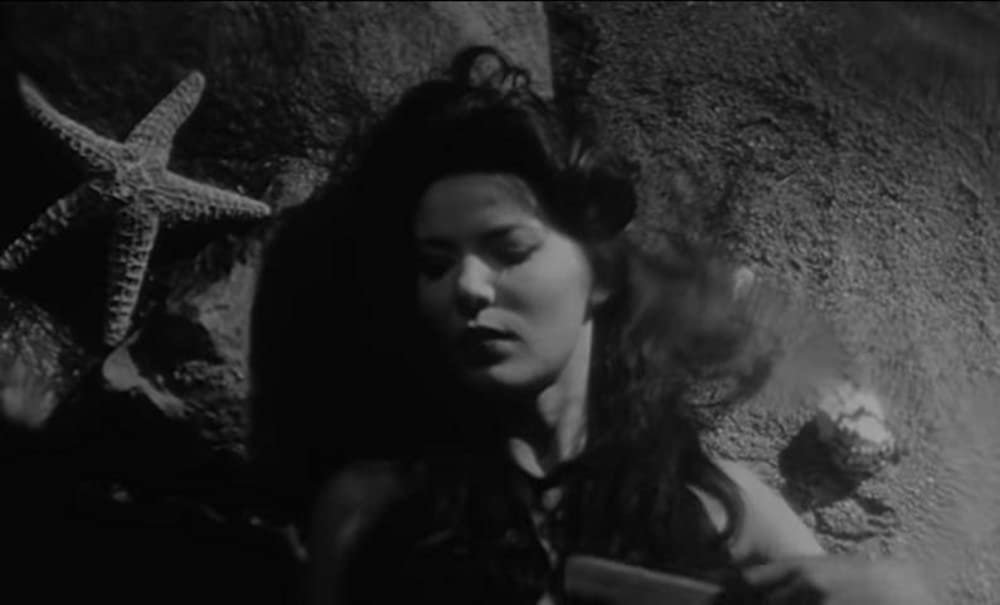
Death in Venice, California
On February 1, 1963, Night Tide lapped like an expressionist wave against the screens of American drive-ins and art houses, not to mention the Times Square grind house where Truman Capote saw, and absolutely treasured, Curtis Harrington’s 1961 opus. Night Tide rolls in with the satiny force of its leading lady, Linda Lawson, whose breathy voice expresses alien intensity lurking behind an opaque curtain of melancholia.
It had spent three years languishing in the can when distributor Roger Corman smuggled the unlikely masterwork into public consciousness, another of his now legendary mitzvahs to art. Throughout Night Tide, a strangely hushed invitation lingers in the air: "Come live above a merry-go-round, have breakfast with a hot sailor and an even hotter mermaid, spend hours with an old drunk captain, listening to the strange tales behind the morbid souvenirs of his life.”

Night Tide
Canonical stature is both fragile and contingent, and that’s why powerful institutions seek to shore up the various canons with rankings and plaudits. We’ll play along by asserting that one of our favorite “B” movies was originally screened by Henri Langlois at the Cinematheque française with Georges Franju in attendance. Night Tide (1961) was an unlikely contender for this particular honor—shot guerrilla-style on an estimated $50,000 budget, and intended, at least by its distributors, for a wider, less demanding audience seeking mostly air-conditioned escapism.

Places Are People: When the Setting is Ready for Its Close-Up
Cinema’s misspent childhood years in late-Victorian fairgrounds are followed by a grimy adolescence in Edwardian nickelodeon parlors. The medium, which finally comes of age amid gaudy palaces built in its honor, morphs many times. However, All Talking Pictures are the final death knell for the Victorian standard, belching from the screen a thousand inbred tongues that invade the ear willy-nilly. They remind us that Victoria Regina breathed her last in January of 1901, and with her passing Naturalism sheds decorum, taste, chivalry, good table manners.
Cinema grew from amusement parks, fairs, shows, an "attraction" for the rubes. And, like calling to like, the movies still nurture a fascination for such places of low pleasure.
As he shot Touch of Evil in and around Los Angeles' Venice Beach on a handful of nights in the early spring of 1957, Orson Welles would bashfully drape those trashy, less cinematic elements of the Mediterranean counterfeit before him in a voguish noir frock coat; one that would, at once, revel in the inherent ghastliness of such a place while concealing its full absurdity from eyes that would never be able to handle the contradiction.
Some years later, fate would conspire to choose Curtis Harrington, a cross-dressing Poe fanatic, to fully capture “The Slum by the Sea” with all its ravaged whimsy set against the lyric humiliation of once-ostentatious digs and the ruined face of spent oil wealth. Singularly unembarrassed by what he saw, Harrington gave audiences a Venice Beach that Welles would not: the sun-dappled occult, the queer, the criminal; a true, flophouse-ridden glory bathed in the endless California sunlight.
Night Tide (1961) assembles a distinguished skid row where underworld docents by the dozen — murderers, perverts, soothsayers and sea witches — pop into being with dazzling efficiency. Picture one thousand elves rising with glee to the same, single-minded curatorial task and you'll have a sense of what is involved here. In other words, as a demiurgic force, Harrington does not emerge from nothingness. After two decades fruitlessly bashing his head against the avant-garde wall, our schlockmeister arriviste goes Hollywood — that is, any imaginable “Hollywood” rude enough to splotch him with flat soda or leave him smelling of hot gravel and exhaust fumes.
With its hinky cast — nonfictional witch, Marjorie Cameron; erstwhile muse to surrealist filmmaker Jean Cocteau, the undersung Babette who usually appears en travesti; and lecherous, booze-addled, fresh-faced Hollywood castoff Dennis Hopper — Night Tide invades the drive-in. A tarot reading at the film’s heart gives Marjorie Eaton her time to shine, traipsing into nickel-and-dime divination from her former life as a painter of Navajo religious ceremonies. Linda Lawson might have issued from an etching by Odilon Redon, with her raven locks and spiritual eyes, our resident sideshow mermaid. Not surprisingly and despite such gentle segues, the film itself traveled a rocky road from festivals to paying venues.
Despite the film’s scant $50,000 budget and somewhat dubious standing (after all, this was the director’s first attempt at feature filmmaking), Harrington captivates well-established eminences like cinematographer Floyd Crosby (Tabu) and composer David Raksin (Laura). Their contributions are keyed with great sensitivity to the film’s teasing invitations: “Do you want to live on a black and white Venice Beach boardwalk, have breakfast with a hot sailor and a hotter mermaid, hang with an old drunk captain and listen to the strange tales behind his morbid souvenirs?” It’s worth mentioning that Truman Capote, after catching a Times Square screening, adored Night Tide. We won’t ask what he was up to in a grind-house theater, but whatever it may have been, Mr. Capote encountered the movie in its ideal environment: equal parts sub-rosa poetry and grim

